The proximity of large cities and the abundance of culture are two of the best features of living on the East Coast. With minimal research, it’s easy to find numerous art events within a two-hour drive from home. At present, I have an old friend from Colorado visiting me, and in exchange for cooking this year’s Thanksgiving turkey, I have treated him to seven concerts in three states within a 10 day period.
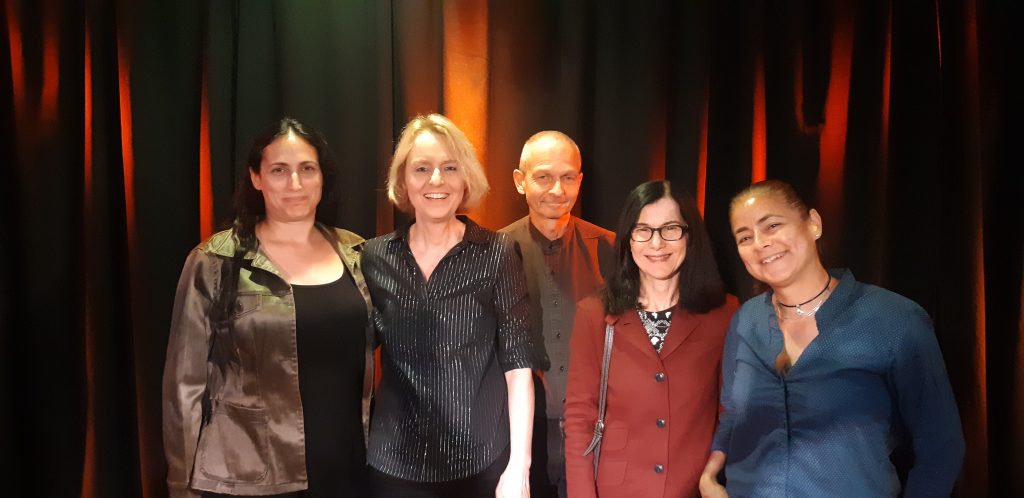
We started with two all-female instrumental combos on consecutive nights. Pianist Monika Herzig brought her group, Sheroes, to the Kennett Flash, an intimate club in Kennett Square, Pennsylvania (just across the Delaware state line). The Flash was Sheroes’ last engagement before the COVID lockdown, so it was entirely appropriate that the group would appear there as they resumed their CD tour. Although the band was smaller than usual (guitarist Leni Stern did not tour with the group, and Herzig’s husband Peter Kienle subbed for the ailing bassist Jennifer Vincent), they played an excellent set featuring compositions by Herzig, flutist Jamie Baum, and trombonist Reut Regev. It took a couple of tunes for the group to get its footing, but on Herzig’s New Orleans march “Parade of Sadness”, they found their groove and never let go. Regev, an expressive and unpredictable trombonist, started the piece as a duet with drummer Rosa Avila, and as Regev alternated between traditional and progressive lines, Avila made the room rock with her scintillating patterns. Herzig carried the song’s growing momentum with a funky solo on her keyboard. Baum’s flutes were not as prominent until, in the midst of a solo on her original ballad, “Seas of Change”, she suddenly engaged an electronic device that doubled her flute lines an octave lower. The additional sonic heft balanced the sounds of the frontline instruments. Despite their last-minute reorganization, the rhythm section played as a cohesive unit, with Avila simultaneously providing color and foundation to the ensemble, Kienle adding deep grooves on electric bass, and Herzig adding spice with short pungent chords. The evening’s highlight was Regev’s wild original, “Up in the Sky”. The trombonist provided the night’s only vocal on this tune, displaying a wide range and remarkable creativity. She followed with a stunning trombone solo that maintained overall logic despite its unusual design.
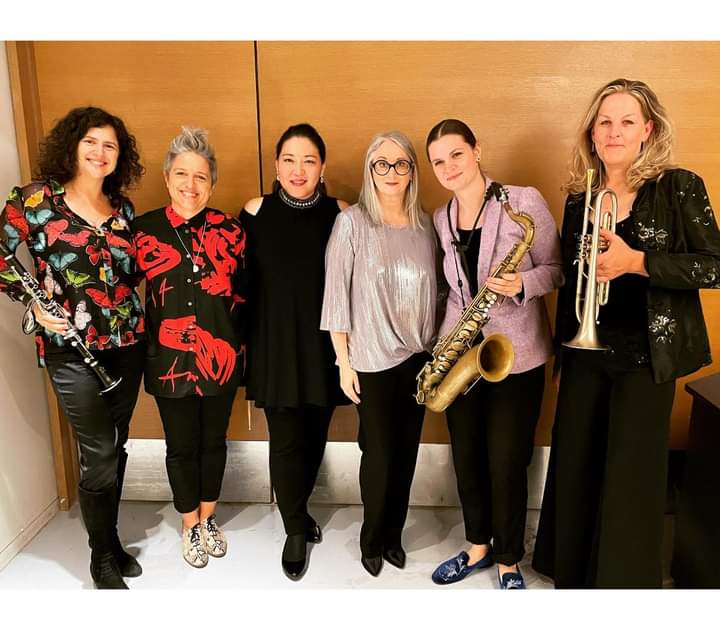
The next day we traveled to NJPAC in Newark, New Jersey. In the afternoon, we viewed a screening of a documentary on the legendary jazz radio station WBGO (which should be available on home video early next year—look for a DVD review here near its release date). The evening started with the other all-female group, Artemis. Led by pianist/artistic director Renee Rosnes, Artemis features some of the best-known female instrumentalists on the scene today: trumpeter Ingrid Jensen, clarinetist Anat Cohen, tenor saxophonist Nicole Glover, bassist Noriko Ueda, and drummer Allison Miller. The set opened with Rosnes’ “Galapagos”. Rosnes played a magnificent solo, as her unique keyboard tone cut through the ensemble. Miller stoked the fires with unrelenting energy. Ueda’s “Step Forward” shifted focus to the bassist, and the quiet mood continued with Cohen’s gorgeous “Nocturno”. Here, the sound balance, which favored Jensen and nearly drowned out Cohen was finally rectified, so we could hear all three parts. Cohen, in supreme form all night, shined especially brightly on this piece, with her fine work in the chalumeau register particularly fine. Jensen led the group through her unique arrangement of “Fool on the Hill” which also included her most brilliant and incisive improvisation of the concert. Glover is the newest member of Artemis—NJPAC was apparently only her second gig with the group—and comparing this performance with her solo album, “Strange Lands”, she is still looking for ways to express herself completely within the band. She will doubtlessly spread her wings with this group, and perhaps all it will take is a little more time within this stellar front line. At the NJPAC concert, she showed some of that promise in solos on “Procrastinator” and “Goddess of the Hunt”. As on their Blue Note debut album, the group did not open up the arrangements for long solos, which allowed us to hear the wide variety of their growing repertoire.
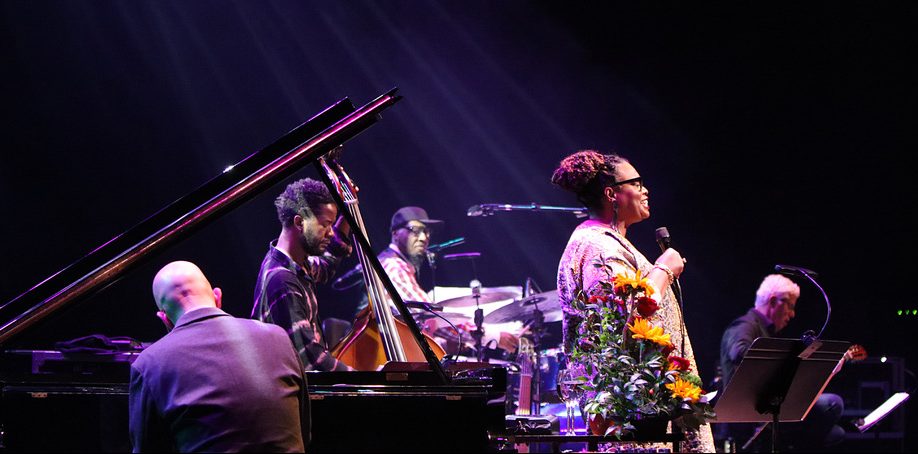
Artemis shared the NJPAC bill with vocalist Dianne Reeves and her band. I caught Reeves at the Clifford Brown festival in Wilmington last August, and the calming, healing tone of that set has subtly transformed into a Brazilian repertoire that is being prepared for a new album. Reeves opened with a solo a cappella version of “Stella by Starlight”. Vocalist Andrea Miller told me that Reeves had sung the entire song unaccompanied at an LA concert a few weeks earlier, but in Newark, she sang the first half chorus alone before cueing in the rhythm section. Although “Stella” did not get a samba treatment, I hope that Reeves commits this magnificent rendition to tape for the new album. The Brazilian tracks began with “Minuano” (which featured an impressive scat solo that highlighted Reeves’ wide vocal range), and continued with a stunning “Nothing Will Be”. With his deep knowledge of Brazilian music and constantly surprising melodic inventions, guitarist Romero Lubambo acted as Reeves’ partner in beautiful versions of Wayne Shorter’s “Infant Eyes” and Johnny Mandel’s “A Time for Love”. Reeves’ other accompanists, pianist Peter Martin, (new) bassist Ben Williams and drummer Terreon Gully, also had their moments in the spotlight, but Lubambo seems to be the center of this new project.
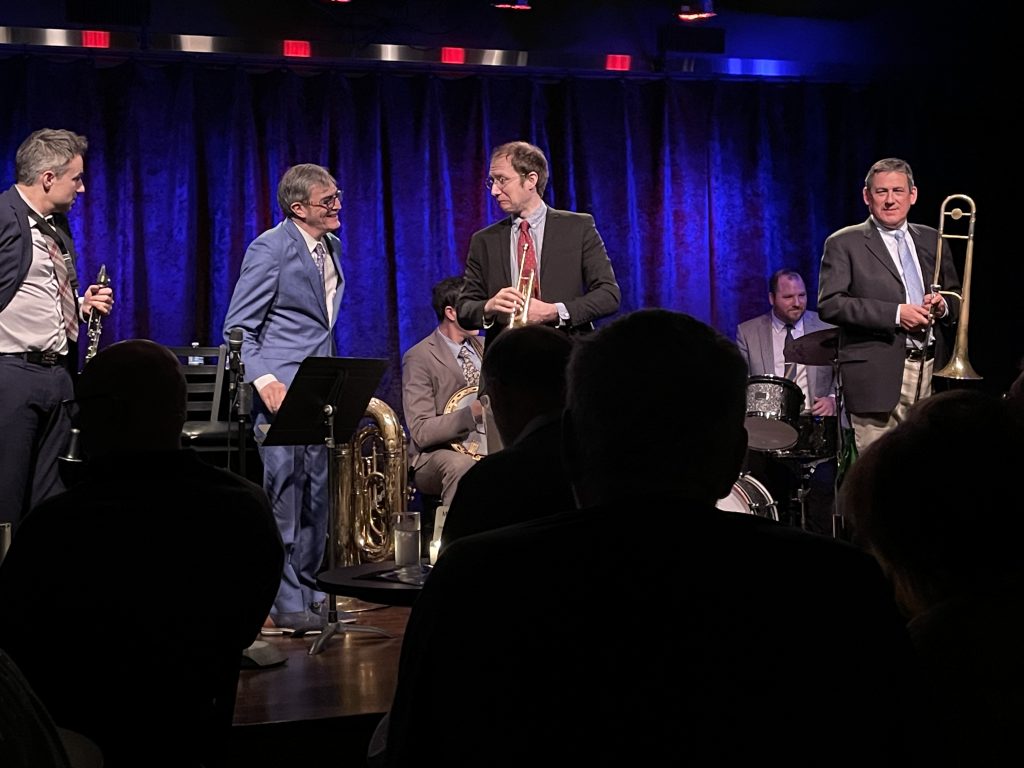
We were in New York Wednesday and Thursday, and (at least for us) it appeared to be classic jazz week in the Big Apple. We caught David Ostwald’s Louis Armstrong Eternity Band at the Birdland Theater late Wednesday afternoon, and the enthusiastic audience was treated to authentic renditions of Armstrong standards such as “Home”, “Blue Turning Grey Over You” and “Weary Blues”. In his solos, trumpeter Joe Boga was particularly careful regarding his note choices. Most of the time he remained in the middle register, saving the high notes for the big endings. Trombonist Jim Fryer had the exuberance of an old-time Dixieland player but also displayed his reserve in several muted solos. Arnt Arntzen held down the basic harmonic frame on banjo and guitar, while Ostwald played great flowing bass lines on his tuba. Drummer Alex Raderman was obviously a crowd favorite, as everyone in the audience chanted his name during the band introductions. He played well within the style, bringing out the brashness only when necessary. Adrian Cunningham stole the show. Not curbing his prodigious clarinet technique, he sounded like a modern-day Benny Goodman, improvising brilliantly in all ranges of the horn. Switching to the rare C-Melody saxophone, he was featured on an elegant version of “Stardust” (complete with verse), and later sang a couple of choruses on “When My Dreamboat Comes Home” and “Swing That Music”. Overall, it was a fun set that would have surely pleased Armstrong himself.
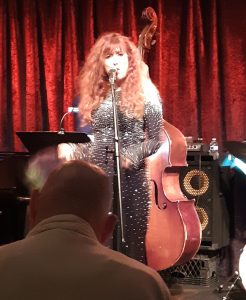
The second set at Birdland that night featured Roberta Donnay and the Prohibition Mob from San Francisco. This was clearly a stage revue, with the musicians all dressed in fedoras and period costumes, and vocalist Donnay appearing in a form-fitting floor-length dress that could have been lifted out of Mae West’s closet. Still, these players are jazz musicians to the core, and they played this music (dating from 1911-1939) with great energy and meticulous attention to stylistic detail. Trumpeter Darren “The Lip” Johnston and trombonist Ric “Throw ‘em in the River” Becker played short, concise solos over the tight rhythm team of Marcus “Knuckle Sandwich” Persiani, bassist/arranger Sam “Shotgun” Bevan, and drummer Dave “Sticks” Gibson. Donnay’s vocal delivery was charming and seductive. Her musicianship reveals that she is not as ditzy as her stage persona indicates, as she brings great understanding to the lyrics, both comic and serious. Near the end of the set, Donnay brought up her friend Kay Kostopoulos dressed as a member of a harem and sporting two pairs of finger cymbals. Her solo on “Boulevard of Broken Dreams” was as close to finger cymbal virtuosity as I’ve ever heard (and if she wasn’t also from the Bay Area, I’d claim this as an “only in New York” moment!) Like the Ostwald band preceding it, Donnay’s Prohibition Mob offered an entertaining show as educational as it was delightful.
Thursday was a full day, with daytime tours of the Louis Armstrong House Museum in Corona, Queens, and the National Jazz Museum of Harlem. I had hoped that my friend Ricky Riccardi would lead our tour, but our tour guide, Adriana, knew the subject well and was able to answer all of our questions. Loren Schoenberg, the director of the Jazz Museum, was available to show us around the Harlem Museum and its fine collection of artifacts and research materials. For jazz fans wanting to know more about the great musicians who created this art form, these two museums come highly recommended. After our visit, we made a quick visit to the site of the Art Kane “Great Day in Harlem” photo before grabbing a subway to Greenwich Village for the first of the evening’s two concerts.
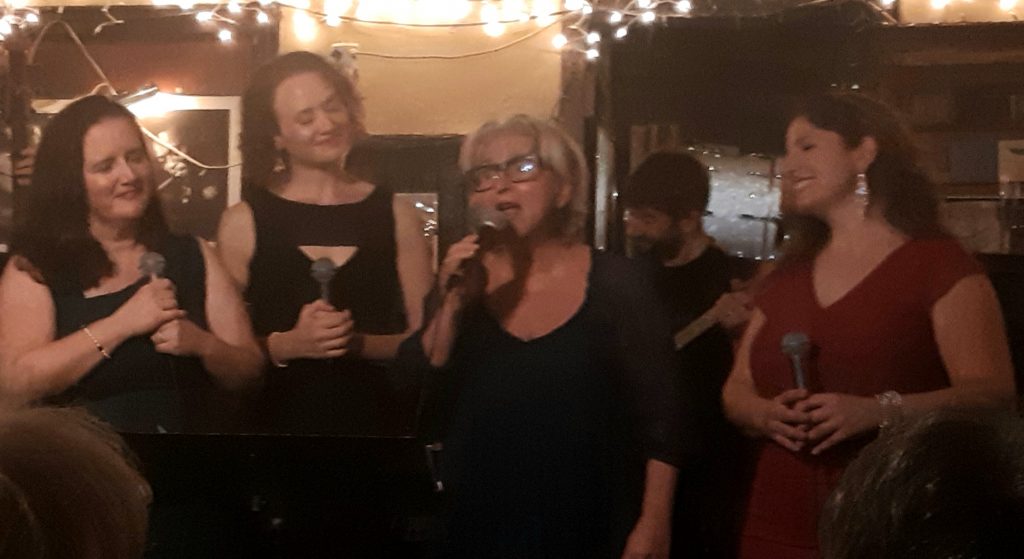
I’ve reviewed Duchess at the 55 Bar in recent months, and under ordinary circumstances, I would not write another notice on the group for another 6 months. But this was a special occasion—Duchess’ 8th anniversary—and the two-set concert featured several of the group’s favorite guests. Anat Cohen joined the group in the first set for wild choruses on “Three Little Sisters”, “Swing, Brother, Swing” and “Heebie Jeebies”. Sweet-voiced Kat Edmonson blended with the trio of Amy Cervini, Hilary Gardner, and Melissa Stylianou on “Que Sera, Sera” (Edmonson admitted beforehand that she was uncertain about the second verse, and as the promised sheet music was still on a printer somewhere, Gardner mumbled the words into Edmonson’s ear as the performance went on!) In the second set, tenor saxophonist Jeff Lederer brought his untethered humor and Albert Ayler-inspired sound to a raucous arrangement of “Strip Polka”. Finally, Manhattan Transfer’s Janis Siegel presented a glorious countermelody to Duchess’ newest arrangement, “We’ll Meet Again”. From the beginning of the first set, the rhythm section of pianist Michael Cabe, guitarist Jesse Lewis, bassist Matt Aronoff, and drummer Jared Schonig played with great energy and abandon, and that energized the vocalists as well. All of the solo features (Cervini’s “Doodlin’ Song”, Gardner’s “Hallelujah, I Love Him So”, and Stylianou’s “Everybody Loves My Baby”) and the ensemble staples (“Heebie Jeebies”, “On the Sunny Side of the Street” and “Here’s to the Losers”) sounded as fresh and vibrant as when I first heard them eight years ago. Happy anniversary, ladies!
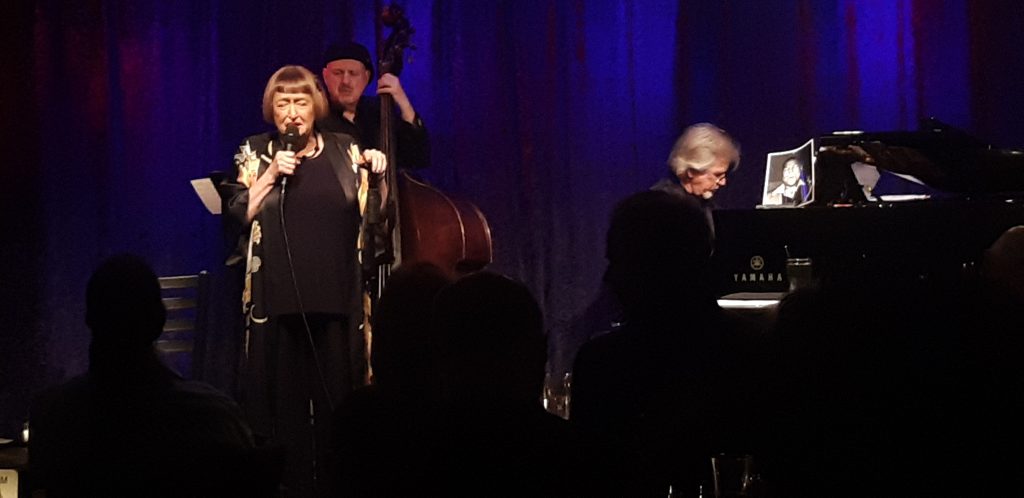
We rushed back to Birdland to catch the last half of Sheila Jordan’s 93rd birthday celebration. It is some sort of miracle when a vocalist in their 90s can still sing with reasonable accuracy. Jordan’s voice has preserved better than several of her peers, and while it is no longer perfect, her passionate delivery can still touch a listener’s heart. In tribute to the recently departed Dave Frishberg, Jordan sang “Heart’s Desire”, a song with Frishberg’s lyrics set to the music of Alan Broadbent (not coincidentally, Jordan’s pianist that night). Jordan missed a few notes, but the message of Frishberg’s words came through very clearly. Since that message of pursuing your deepest-held goals is also key to Jordan’s life and work, she reiterated it in her next spoken announcement: follow your dream no matter what it takes. Jordan paid tribute to her greatest mentor, Charlie Parker, with “The Bird” (“Quasimodo”) from Roseanna Vitro’s CD “Sing a Song of Bird”, and an autobiographical blues. One of Jordan’s greatest partners, Harvie S, was a welcome and solid presence on bass throughout.
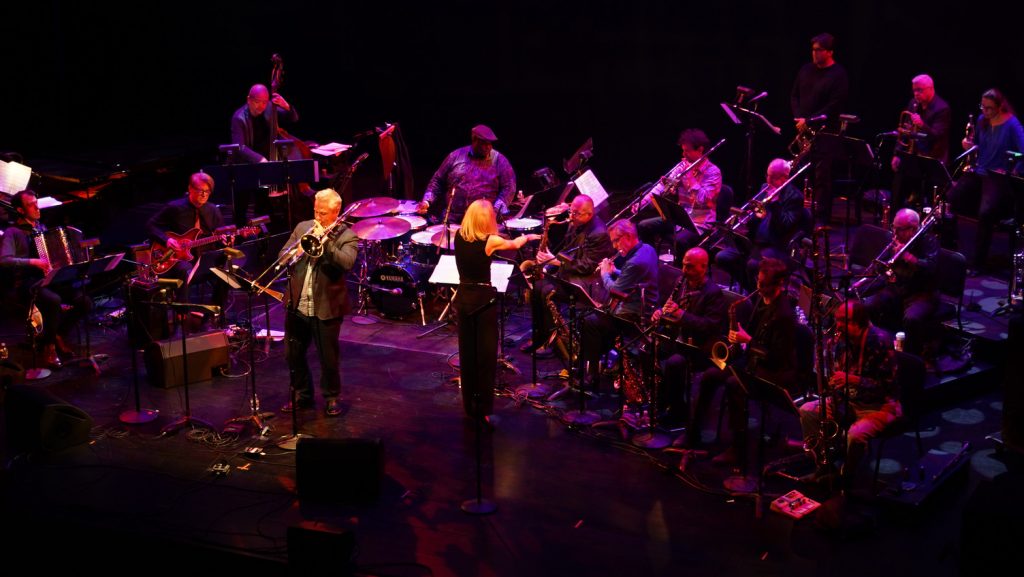
We took a break from music for the next two days, as we did a sightseeing trip in Washington, DC. Sunday, we returned to Newark and NJPAC for a wonderful concert by the Maria Schneider Orchestra. All but one of the compositions came from Schneider’s highly-acclaimed album, “Data Lords”, and the pieces alternated between the hard-edged diatribes against Google and YouTube (“Don’t Be Evil”, “Look Up”, and “Data Lords”) and spacier, pastoral sounds (“Bluebird”, “The Thompson Fields” and “CQ, CQ, Is Anybody There”). Virtually all of the horn players remained as on the original double-CD: Tony Kadleck, Mike Rodriguez, Nadje Noordhuis, and Liesl Whitaker (replacing Greg Gisbert) on trumpets; Keith O’Quinn, Ryan Keberle, Marshall Gilkes, and George Flynn on trombones; Steve Wilson, Dave Pietro, Rich Perry, Donny McCaslin, and Scott Robinson on reeds, but the rhythm section was almost all new: Gary Versace moved from accordion to piano, with Julien Labro as his replacement, Nels Cline is the new guitarist, Kiyoshi Kitagawa has the bass chair, while Johnathan Blake remains on drums. Blake is the perfect drummer for Schneider’s turbulent music. Placed at center stage with his kit set closer to the floor than most drummers, Blake moved effortlessly across the various tom-toms, sometimes producing deep rolls with large mallets. Cline was also a valuable addition, not only providing dramatic solos on his guitar but also producing unique effects which added to the overall soundscape (as he did on “A World Lost” when he played a solo on a vintage lap steel guitar). The horn soloists—principally Rodriguez, Keberle, Gilkes, and all of the saxophonists—play unique roles in Schneider’s scores: while they are free to play as they wish, the soloists also contribute to Schneider’s overall sound patterns. She has a general idea of what each soloist will play, and her backgrounds fill in the rest. For those who consider Schneider’s latest works non-melodic, my best advice is to become engulfed in the sound as a whole. It is quite remarkable to hear all of the sounds that can be created by a 17-piece big band.